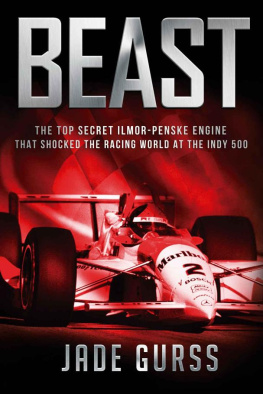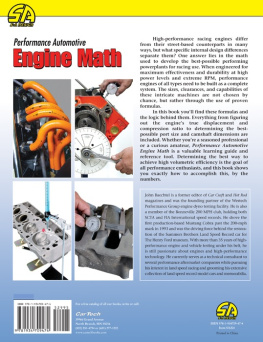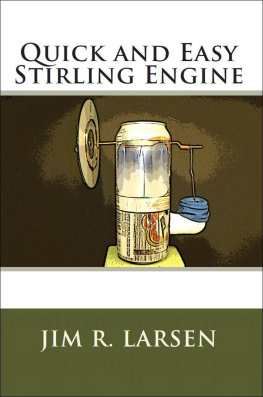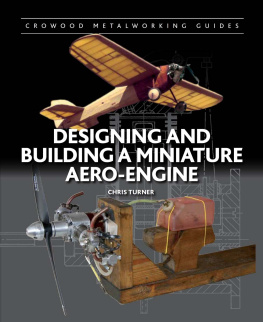BEAST
BEAST
THE TOP-SECRET PENSKE-ILMOR ENGINE THAT SHOCKED THE RACING WORLD AT THE INDY 500
JADE GURSS

Octane Press, Edition 1.0, May 2014
Copyright 2014 by Jade Gurss
All rights reserved. With the exception of quoting brief passages for the purposes of review, no part of this publication may be reproduced without prior written permission from the publisher.
ISBN 1937747336
ISBN-13: 978-1-937747-33-6
Copyedited by John Koharski
Proofread by Steve Casper
Interior Design by Tom Heffron
Cover Design by Ravastra Studios

octanepress.com
This book is dedicated to the memory of Paul Morgan
19482001
CONTENTS
FOREWORD
C reating the pushrod engine for the 1994 Indianapolis 500 was the most intense project of my working life. We had only one chance for it to succeed. One race, one chance.
For nearly a decade, Indy 500 rules had given stock-block pushrod engines (built with Buick V6 stock blocks) several advantages over double-overhead-cam engines. But while the Buick engines had been competitive on speed, they were not reliable. No stock-block engines finished in the top fifteen of the 1993 Indianapolis 500, and only one Buick engine had ever completed the full five-hundred-mile distance in nine years. USAC [United States Auto Club, the races sanctioning body] relaxed the rules in an effort to help make Buick more competitive and reliable. The rule changes, which removed the requirement to use a stock block, also meant nothing could stop anybody from designing a new pushrod engine from the ground up. USAC hoped to help Buick, but they opened the door for everyone else.
So after one meeting in June 1993, Ilmor cofounders Roger Penske, Paul Morgan, and I committed to the challenge to build a pushrod engine of our own. To be handed so much advantage on a plate was a once-in-a-lifetime opportunity. We all knew we had only one chance to build an engine from a clean sheet of paper before our competitors could respond or the engine was banned.
It was definitely a challenge. Because the time frame for such an undertaking was almost impossible, every element had to be right or the project would fail. The engine had to be ready to race five hundred miles less than ten months after the first line was drawn.
The effort and commitment required from everybody involved was immense. Everything had to be a secret. The whole workforce involved at Ilmor and at Team Penske had strict instructions not to talk about it to anybody. That was an absolutely key element. Today I am still very happy and satisfied that we could surprise the racing fraternity before Indy opened its gates in May 1994.
Now the rest of the world has an opportunity to learn of this immense effort. How did it turn out? Youll have to read the book.
Mario Illien
Cofounder, Ilmor Engineering Ltd.
Designer, Mercedes-Benz 500I engine for the 1994 Indianapolis 500
PREFACE
T o say this book is a labor of love would be an understatement. I attended the historic 1994 Indianapolis 500 as a fan, but it wasnt until several years later that I began to learn the untold stories that added up to a thrilling and intriguing tale of mystery. Ive wanted to share the story contained in these pages (or pixels) ever since.
The anecdotes began trickling in while I was coordinating sports publicity for Mercedes-Benz USA at Cotter Communications, a motorsports agency near Charlotte, North Carolina. I was then hired by Ilmor Engineering, the racing-engine design and manufacturing arm of Mercedes-Benz, near the end of 1996. Hearing my coworkers tell the stories over dinner (usually after a few beers) set my mind reeling with intense fascination.
I consider it one of the greatest racing stories of all time and certainly one of the most compelling in the more than one hundred years of the Indianapolis 500. Its a deeply human tale with many business and motivational lessons, and an example of what can be achieved when you have smart and motivated people devoted to a common cause.
Immense heartbreak overtook me at the passing of Ilmor cofounder Paul Morgan in 2001. Not only was he a man I liked and respected immensely, but he was the fulcrum at the heart of many of the top-secret tales. I worried that many of the details had died with him and Ive tried to do my best to honor his memory by striving to write the definitive version of the story.
In the majority of my interviews, many current and past Ilmor and Penske employees explained how they had been so busy with their small slice of this project that they still have no idea what their fellow employees were doing across the ocean or even in the next room. I hope this book helps them discover those things and also lives up to their extreme level of effort and professionalism. I also hope the reader feels their passion jump from each page.
Thanks to Mario Illien, cofounder of Ilmor, and Roger Penske, the man at the head of Penske Racing and many other companies, for their willingness to allow me to tell the story of their leadership and vision.
Jade S. Gurss
April 2014
ONE
THE FLIGHT
THINGS NEEDED TO BE DONE
P aul Morgan left the small British village of Brixworth on a six-mile drive to the Sywell Aerodrome. The winding and bucolic route was perfect for a leisurely drive, but this was Paul Morgan: a man obsessed with speed. He accelerated quickly on the tree-lined roads, past farmhouses and roundabouts. He was carrying critical cargo produced overnight by the company he cofounded. For Morgan, the clock was always ticking.
Morgans mission was a small part of a larger top-secret project known to only a handful of the good folks of Brixworth. The few who knew were doing extraordinary work, putting in the hours at their normal jobs then working through the night on the new undertaking. They had been urged not to tell anyone, including their spouses.
This morning, Morgans fourteen-year-old son Patrick was pressed into action, bicycling from home to the nearby airfield, arriving long before his father. Patrick was in charge of preparing and warming up the V12 Rolls-Royce Merlin engine in the P-51D Mustang, one of the greatest warplanes ever built. Patrick started the engine, a not-so-easy task for a teenager with only two hands, as he simultaneously regulated the RPM, fuel mix, primer, and starter. Soon, the Mustang was ready for its sortie from Sywell, an airfield dotted with sparse hangars and a squat but sturdy control tower. Built in 1928, it was typical of the era, with three runways arranged in a triangular pattern to allow takeoffs and landings even if two of the runways were damaged.
The P-51D Mustang is a perfect example of engineering and design driven entirely by function. Nothing superfluous, nothing built for comfort. Its sleek and sexy shape was augmented by a bulletproof windshield, a clear bubble canopy over the pilot, and an aerodynamic bullet of a nose housing a four-blade propeller. Commissioned by Britains Royal Air Force in 1940, the Mustangs prototype had been built in an amazing 102 days by North American Aviation in California. The plane was svelte and compact, yet featured a large fuel capacity, allowing it to escort massive bombers farther than any previous fighter. Originally built using a less-powerful Allison V-1710 engine, the plane didnt reach full potential until it was fitted with the British-designed Rolls-Royce power-plant. The new engine elevated the Mustang to the ideal intersection of raw, guttural power, aerodynamic efficiency, and high-altitude, long-range capabilityeach essential to a successful fighter.
Next page










